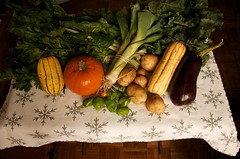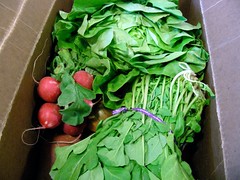Here are a few ideas you can start with:
#1. Start with one thing at a time. Going organic doesn’t mean you have to go all or nothing. Take small steps to where you want to go. I also recommend downloading the EWG (Environmental Working Group) Dirty Dozen list that shows you the produce that is most likely to be grown with the most pesticides, so either avoid those or purchase them organically. The list includes items like cherries, bell peppers, peaches, potatoes, blueberries, spinach, celery, strawberries and more. They also keep a list of produce that is least likely be grown with as much pesticide, so you may not have to rush into organic versions of those.
You can get the list or download a mobile app here: http://www.ewg.org/foodnews/
| Stoneledge farms CSA (Community Supported Agriculture) Local Farming Week Seventeen (Photo credit: smith_cl9) |
#3. Cut out expensive (and unhealthy) processed foods. While processed foods may seem like a great deal because they save time and they appear to be inexpensive, they often don’t provide a lot in the way of portion size or nutritional value and can really eat up a food budget if you rely on them. Try reducing the amount of processed foods you buy and eat more nutrient dense whole foods. It’s good for the budget and good for your health.
#4. Stock up when things go on sale and then can, dry or freeze it. It’s the same money-saving concept that people have been using for years and you can apply it to organic foods as well. Invest in a food dehydrator, canning equipment and freezer-ready containers, so you can store organic foods for later eating.
#5. Make it a goal to eat a fully local and/or organic meal each week. It’s an idea borrowed from http://www.thedailygreen.com/healthy-eating/latest/green-diet-local-meal-44013008 and it’s a good one. If you just try for one meal, you’ll be making a difference without a lot of cost. Plus, leftovers and extra ingredients can be stretched out to additional meals.
#6. Eat more vegetarian meals. I know might sound scary for some meat lovers, me included, but eating more meatless meals gives you so much more money in the food budget. Or if you’re not ready to do completely vegetarian, consider using smaller portions of meat in your meals. Try things like stir fries and casseroles where meat is simply an accompaniment, rather than the main focus of the meal. I've come to use meat often more as a flavoring than as a main ingredient - it really can stretch the budget, and still give you the taste of meat that you love. (For example - pea soup with a ham bone, or just a small piece of ham, or one of my favorites - red beans & rice with just a little bit of ham diced small, and a little bit of ultra-flavorful chorizo sausage and lots of spices. There are lots of great ways to include small amounts of meat in your diet without going overboard - not only is this easier on your wallet, but many studies show it's also easier on your body.)
| (Photo credit: yksin) |
#8. Grow your own! Often one of the easiest and most overlooked ways to eat organic foods - is to grow them yourself. Organic and sustainable gardening is more and more popular these days, and for good reason. Not only is it a fun and rewarding hobby, but it can provide the freshest and healthiest food possible - picked at the peak of ripeness and nutritional value - from your own garden! Visit our sustainable gardening blog for lots of helpful tips and articles on this at: http://nhlsustainablegardening.blogspot.com/
Every little bit helps and the better you get at picking the right foods, the more affordable it can be. And remember, the long term health benefits of eating more naturally will likely save you plenty in health costs in the long run.
Just one thing before you head out and stock up on everything…we should talk about what organic really means and we’ll do that in my next post.
Other Helpful Resources:



No comments:
Post a Comment